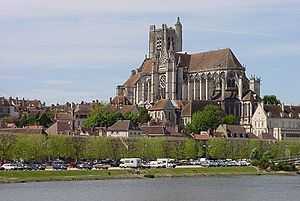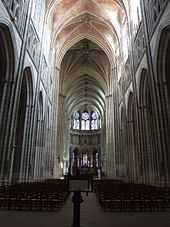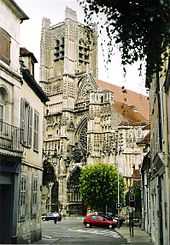Auxerre Cathedral

Auxerre Cathedral (Cathédrale Saint-Étienne d'Auxerre) located in Auxerre, Burgundy, France, dedicated to St Stephen, is known for its expansive stained glass windows.[1]
Most of the Burgundian Gothic cathedral was built between 1215 and 1233 above an 11th-century crypt. Construction continued until the 1540s when the cupola, in Renaissance style that takes the place of one pinnacle on the completed tower, was completed. The first building campaign erected the chevet at the liturgical east end,[2] followed later in the century by a new façade and the bases of new towers at the west end (still linked to the apse end by the nave of the old cathedral). Construction on the nave and transepts proceeded slowly throughout the 14th and 15th centuries.

The narrative sculptural program of the portals on the west end are noted for their extent and variety.[3] Guillaume de Seignelay, bishop of Auxerre decided to undertake the reconstruction of the older edifice about 1215,[4] to which he set an example by contributing heavily and consistently from his own resources, and even bequeathed funds after his transfer to the see of Paris in 1220.[5] The chevet was completed by his successor, Henri de Villeneuve (1220–34); he left 1000 livres for the project, but construction slowed after his death, hampered by a dearth of funds.
Stimulus was provided about 1270 by Jean de Châlons-Rochefort, who had recently become Count of Auxerre, having supported the Duke of Burgundy against his own brother, by marrying Alix, the heiress of Auxerre. He was the largest fief-holder in the Duchy and commemorated the new status of his fief of Auxerre by enriching the front of its chief ornament, the cathedral, whose Carolingian nave had been erected by his ancestor Hugh de Châlons, 10th-century bishop of Auxerre. Its program of sculpture was carried through long after his death and completed in the early 15th century.[6]

The diocese
Auxerre was formerly an important diocese in Gaul, with a bishop as early as the 3rd century; the diocese was suppressed in 1821.[7] A council held at Auxerre in 585 (or 578) under bishop Annacharius formulated forty-five canons, closely related in context to canons of the contemporary first and second Councils of Lyon and the Council of Mâcon. "They are important as illustrating life and manners among the newly-converted Teutonic tribes and the Gallo-Romans of the time", the Catholic Encyclopedia asserts. Many of the decrees were directed against remnants of paganism and non-Christian customs; others bore witness to the persistence in the early Middle Ages in France of certain ancient Christian customs. The canons of the council of 695 or 697 were concerned chiefly with the Divine Office and ecclesiastical ceremonies.[8]
See also:
- Saint Germanus of Auxerre, bishop of Auxerre (died 448)
- Desiderius of Auxerre, bishop, died 621)
- Remigius of Auxerre, theologian and teacher (died 908)
- William of Auxerre, theologian
Notes
- ↑ The glass was reassembled after a Protestant iconoclastic attack on it in 1567; Virginia Chieffo Raguin, "The Genesis Workshop of the Cathedral of Auxerre and Its Parisian Inspiration" Gesta 13.1 (1974:27-38) p. 28.
- ↑ The first Burgundian example of the High Gothic; Harry B. Titus, Jr., "The Auxerre Cathedral Chevet and Burgundian Gothic Architecture" The Journal of the Society of Architectural Historians 47.1 (March 1988:45-56) p.
- ↑ Don Denny, "Some Narrative Subjects in the Portal Sculpture of Auxerre Cathedral" Speculum 51.1 (January 1976:23-34).
- ↑ His vita in Gesta Pontificum Autissiodorensium is the primary source for the building campaign.
- ↑ C. Porée, La cathédrale d'Auxerre (Paris) 1926.
- ↑ Denny 1976:
- ↑ Catholic Hierarchy: diocese of Auxerre (Suppressed).
- ↑
 "Councils of Auxerre". Catholic Encyclopedia. New York: Robert Appleton Company. 1913. The source doesn't give a clear date for the councils.
"Councils of Auxerre". Catholic Encyclopedia. New York: Robert Appleton Company. 1913. The source doesn't give a clear date for the councils.
External links
- "Welcome to Auxerre Cathedral"
- Auxerre Cathedral bibliography
- Photos
- Catholic Encyclopedia 1908: "Councils of Auxerre" "(Sens):Diocese of Auxerre"
| Wikimedia Commons has media related to Auxerre Cathedral. |